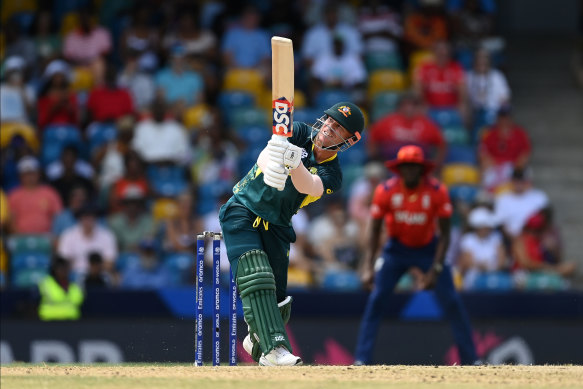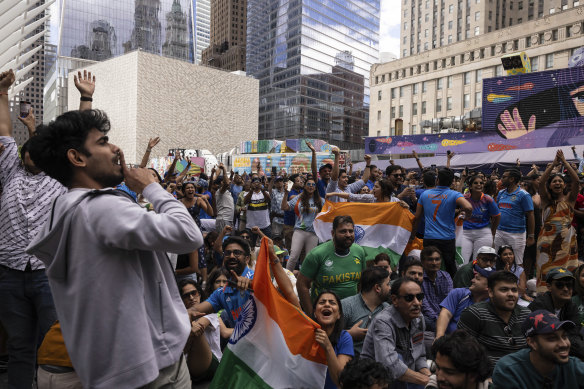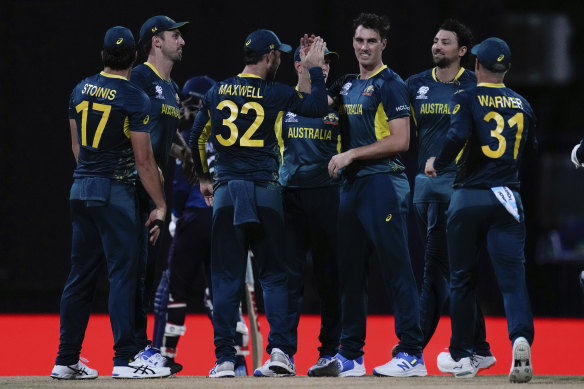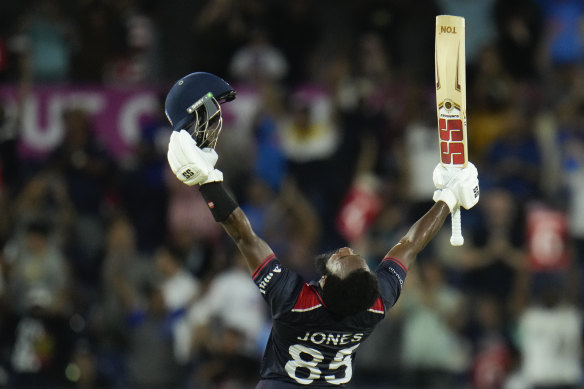This was published 5 months ago
USA, Afghanistan upset heavyweights in topsy-turvy T20 World Cup
By Malcolm Conn
The Twenty20 World Cup is about to get serious, with the United States and Afghanistan qualifying for the next stage as Pakistan, New Zealand, Sri Lanka are all set to be tipped out of the tournament.
Unfriendly viewing times and a new live sports streamer have left the tournament struggling to capture Australia’s attention during the football seasons, but there has been plenty going on.
With the KO-ing of Queensland’s dancing prince, Reece Walsh, early in the State of Origin opener, the Swans’ spectacular winning streak and the demise of the Melbourne Rebels Super Rugby team, only keen cricket fans will be aware of the mixed fortunes in an expanded 20-team tournament full of minnows.
Most will be eliminated by Tuesday when the group stage ends, with the Super Eights, or quarter-finals, beginning on Thursday.
Australia, India, South Africa and the West Indies have also already secured their places in the next stage, but it is the USA’s advance after a washout against Ireland in Florida on Saturday morning (AEST) which has added an unexpected twist.
The extra point from the washout left the USA second in Group A behind India but ahead of Pakistan, who they had already beaten in a dramatic super over. The top two teams from the four groups of five all go through to the Super Eights.
In the Super Eights, there are two groups of four, with the top two teams from each group progressing to the semi-finals.
England also suffered a scare after a washout against Scotland and a loss to Australia, but will go through on run rate if they beat Namibia and Australia beat Scotland on Sunday morning (AEST).
While Fox Sports and Kayo are usually the home of cricket streaming in Australia, the decision by the International Cricket Council to award the rights to Prime Video has required a significant change of viewing habits for many sports followers.
So, for all those wondering what’s been going on, here’s a snapshot.
Is this peak Australia?
With David Warner on his last lap for Australia is this Twenty20 World Cup as good as it gets for the current band of heroes?
If they raise the trophy to create a unique trifecta, combining the T20 World Cup title with the one-day World Cup and World Test Championship, will they be celebrating history looking down the other side of the mountain? Will Australia have reached their Everest?

David Warner is Australia’s leading run-scorer in the Twenty20 World Cup.Credit: Getty Images
The selectors have backed experience at every turn with some strong results, but player churn is rapidly approaching and Warner is first off the perch.
Most of the squad are aged 30 or older, with five of the current side 34 or older: Warner (37), Matthew Wade (36), Glenn Maxwell (35), Marcus Stoinis (34) and Mitchell Starc (34).
The Test side is even greyer, with Usman Khawaja (37), Nathan Lyon (36) and Steve Smith (35), while reserve fast bowler Scott Boland is also 35. By moving Smith up to open following Warner’s Sydney Test retirement, it allowed Australia to slot their one player under 30, Cameron Green (25), into the Test team.
No one has had their stay in the Australian side questioned more than Warner, with the latest clamour to get Jake Fraser-McGurk, 22, into Australia’s T20 squad after some extraordinary IPL performances.
“I don’t understand why it’s always about myself,” Warner said this week.
He was Australia’s leading run-scorer as they beat Oman, England and Namibia on the way to qualifying for the Super Eights.
Are India becoming the Washington Generals?
India may be the Harlem Globetrotters of cricket, with their imposing team enjoying a fevered following around the world from the vast Indian diaspora.
However, when it comes to world events, they perform more like the Washington Generals, the forever beaten stooges of the Globetrotters.

India’s powerful team has not won a major world event for 11 years.Credit: AP
Australia could not have highlighted this more graphically last year, when they thrashed India by 209 runs to claim the World Test Championship at The Oval in June, then strangled them in the one-day World Cup final to win by six wickets with 42 balls to spare in November.
It was also the eighth time since 2013 that India had made the semi-final or final of a major International Cricket Council event and failed to claim the title.
Hear those whinging Poms?
Somehow it was going to be Australia’s fault if England failed to advance.
Off the back of the approaching first anniversary of Jonny Bairstow’s stumping at Lord’s during the Ashes, when he marched out of his crease while the ball was still live, the nebulous concept of the spirit of cricket is being dredged up again.
England’s cricket commentariat feared that Australia, having qualified for the Super Eights, would play dead against Scotland, allowing the Scots to get through ahead of England on run rate.
Pat Cummins denied this, but having already rested him and Mitchell Starc, Australia may rest more players against Scotland given their heavy IPL workload in recent months. Coach Andrew McDonald and captain Mitchell Marsh have suggested as much.

Pat Cummins celebrates a wicket with teammates.Credit: AP
This, apparently, is an international crime.
“That is about as far from the true idea of the spirit of cricket as one could imagine,” thundered Simon Heffer in the London Telegraph.
Are 20 teams too many?
Yes, if Australia’s demolition of Namibia and England’s crushing of Oman are any guide. Australia bowled Namibia out for 72 and scored the runs in 5.4 overs. England trumped this by dismissing Oman for 47 and running that down in 3.1 overs. Hardly competitive cricket.
No, given the joy and surprising success of the United States playing in their home country.
Expanding the competition from 16 to 20 teams has given more cricket nations greater incentive to compete on the world stage and raised the sport’s profile in more countries.

USA batsman Aaron Jones celebrates his team’s opening match victory against Canada after hitting 10 sixes.Credit: AP
But the major prerequisite is that India play as many matches as possible. In this case, seven before the semi-finals and final.
It is the billions generated by India through television rights and distributed by the ICC as dividends that keeps most cricketing countries alive.
New York, New York and the USA
By giving the USA 16 matches as joint hosts with the West Indies, including eight at a pop-up stadium on the outskirts of New York, the ICC has shown there is indeed a place for cricket in the world’s largest sports market.
The complication is that India must be playing. While the drop-in pitch has been disappointing, preventing free stroke play, near-capacity crowds of more than 30,000 have turned up for India’s three group matches at Nassau County International Cricket Stadium on Long Island.
The USA’s victory over Pakistan in a super over last week was next level. It was their second win after a high-scoring match against Canada, where Aaron Jones, USA-born but Barbados-raised, hit 10 sixes, showing off his Caribbean heritage.
With streaming figures a closely guarded secret, it’s difficult to know how many people noticed.
Sports news, results and expert commentary. Sign up for our Sport newsletter.